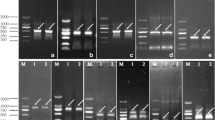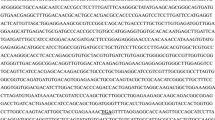Abstract
The halophyte Suaeda salsa can grow in heavy metal-polluted areas along intertidal zones having high salinity. Since phytochelatins can eff ectively chelate heavy metals, it was hypothesized that S. salsa possessed a phytochelatin synthase (PCS) gene. In the present study, the cDNA of PCS was obtained from S. salsa (designated as SsPCS) using homologous cloning and the rapid amplification of cDNA ends (RACE). A sequence analysis revealed that SsPCS consisted of 1 916 bp nucleotides, encoding a polypeptide of 492 amino acids with one phytochelatin domain and one phytochelatin C domain. A similarity analysis suggested that SsPCS shared up to a 58.6% identity with other PCS proteins and clustered with PCS proteins from eudicots. There was a new kind of metal ion sensor motif in its C-terminal domain. The SsPCS transcript was more highly expressed in elongated and fibered roots and stems (P<0.05) than in leaves. Lead and mercury exposure significantly enhanced the mRNA expression of SsPCS (P<0.05). To the best of our knowledge, SsPCS is the second PCS gene cloned from a halophyte, and it might contain a diff erent metal sensing capability than the first PCS from Thellungiella halophila. This study provided a new view of halophyte PCS genes in heavy metal tolerance.
Similar content being viewed by others
References
Ahmad M A, Gupta M. 2013. Exposure of Brassica juncea (L) to arsenic species in hydroponic medium: comparative analysis in accumulation and biochemical and transcriptional alterations. Environ. Sci. Pollut. Res., 20(11): 8141–8150, http://dx.doi.org/10.1007/s11356-013-1632-y.
Altschul S F, Madden T L, Schäffer A A, Zhang J H, Zhang Z, Miller W, Lipman D J. 1997. Gapped BLAST and PSIBLAST: a new generation of protein database search programs. Nucleic Acids Res., 25(17): 3389–3402, http://dx.doi.org/10.1093/nar/25.17.3389.
Boyce R, Chilana P, Rose T M. 2009. iCODEHOP: a new interactive program for designing COnsensus-DEgenerate hybrid oligonucleotide primers from multiply aligned protein sequences. Nucleic Acids Res., 37 (S2): W222–W228, http://dx.doi.org/10.1093/nar/gkp379.
Brulle F, Cocquerelle C, Wamalah A N, Morgan A J, Kille P, Leprêtre A, Vandenbulcke F. 2008. cDNA cloning and expression analysis of Eisenia fetida (Annelida: Oligochaeta) phytochelatin synthase under cadmium exposure. Ecotox icol. Environ. Safe ty, 71(1): 47–55, http://dx.doi.org/10.1016/j.ecoenv.2007.10.032.
Cobbett C S. 1999. A family of phytochelatin synthase genes from plant, fungal and animal species. Trends in Plant Sci ence, 4(9): 335–337, http://dx.doi.org/10.1016/S1360-1385(99)01465-X.
Cong M, Lv J S, Liu X L, Zhao J M, Wu H F. 2013. Gene expression responses in Suaeda salsa after cadmium exposure. Springer Plus, 2 (1): 232, http://dx.doi.org/10.1186/2193-1801-2-232.
Gawel J E, Ahner B A, Friedland A J, Morel F M M. 1996. Role for heavy metals in forest decline indicated by phytochelatin measurements. Nature, 381(6577): 64–65, http://dx.doi.org/10.1038/381064a0.
Grill E, Löffler S, Winnacker E L, Zenk M H. 1989. Phytochelatins, the heavy-metal-binding peptides of plants, are synthesized from glutathione by a specific glutamylcysteine dipeptidyl transpeptidase (phytochelatin synthase). Proc. Nat l. Acad. Sci. USA, 86(18): 6838–6842, http://www.ncbi.nlm.nih.gov/pubmed/16594069.
Heiss S, Wachter A, Bogs J, Cobbett C, Rausch T. 2003. Phytochelatin synthase (PCS) protein is induced in Brassica juncea leaves after prolonged Cd exposure. J. Exp. Bot., 54(389): 1833–1839, http://www.ncbi.nlm.nih. gov/pubmed/12815036.
Hirata K, Tsujimoto Y, Namba T, Ohta T, Hirayanagi N, Miyasaka H, Zenk M H, Miyamoto K. 2001. Strong induction of phytochelatin synthesis by zinc in marine green alga, Dunaliella tertiolecta. J. Biosci. Bioeng., 92(1): 24–29, http://dx.doi.org/10.1016/S1389-1723(01)80193-6.
Inouhe M, Ito R, Ito S, Sasada N, Tohoyama H, Joho M. 2000. Azuki bean cells are hypersensitive to cadmium and do not synthesize phytochelatins. Plant Physiology, 123(3): 1029–1036, http://dx.doi.org/10.1104/pp.123.3.1029.
Lequeux H, Hermans C, Lutts S, Verbruggen N. 2010. Response to copper excess in Arabidopsis thaliana: impact on the root system architecture, hormone distribution, lignin accumulation and mineral profile. Plant Physiol. Biochem., 48(6): 673–682, http://dx.doi.org/10.1016/j.plaphy.2010.05.005.
Liu X L, Yang C Y, Zhang L B, Li L Z, Liu S J, Yu J B, You L P, Zhou D, Xia C H, Zhao J M, Wu H F. 2011. Metabolic profiling of cadmium-induced effects in one pioneer intertidal halophyte Suaeda salsa by NMR-based metabolomics. Ecotoxicology, 20(6): 1422–1431, http://dx.doi.org/10.1007/s10646-011-0699-9.
Livak K J, Schmittgen T D. 2001. Analysis of relative gene expression data using real-time quantitative PCR and the 2 C T method. Methods, 25(4): 402–408, http://dx.doi. org/10.1006/meth.2001.1262.
Manier N, Brulle F, Le Curieux F, Vandenbulcke F, Deram A. 2012. Biomarker measurements in Trifolium repens and Eisenia fetida to assess the toxicity of soil contaminated with landfill leachate: a microcosm study. Ecotoxicol. Environ. Saf ety, 80: 339–348, http://dx.doi.org/10.1016/j.ecoenv.2012.04.002.
Manousaki E, Kalogerakis N. 2011. Halophytes present new opportunities in phytoremediation of heavy metals and saline soils. Ind. Eng. Chem. Res., 50(2): 656–660, http://dx.doi.org/10.1021/ie100270x.
Mao T Y, Dai M X, Peng S T, Li G L. 2009. Temporal-spatial variation trend analysis of heavy metals (Cu, Zn, Pb, Cd, Hg) in Bohai Bay in 10 Years. J. Tianjin Univ., (9): 817–825. (in Chinese with English abstract)
Mendoza-Cózatl D G, Rodríguez-Zavala J S, Rodríguez-Enríquez S, Mendoza-Hernandez G, Briones-Gallardo R, Moreno-Sánchez R. 2006. Phytochelatin-cadmiumsulfide high-molecular-mass complexes of Euglena gracilis. FEBS J., 273(24): 5703–5713, http://dx.doi.org/10.1111/j.1742-4658.2006.05558.x.
Nguyen-Deroche T L N, Caruso A, Le T T, Bui T V, Schoefs B, Tremblin G, Morant-Manceau A. 2012. Zinc affects differently growth, photosynthesis, antioxidant enzyme activities and phytochelatin synthase expression of four marine diatoms. Scientific World Journal, 2012: 982957, http://dx.doi.org/10.1100/2012/982957.
Pandey N, Singh G K. 2012. Studies on antioxidative enzymes induced by cadmium in pea plants (Pisum sativum). J. Environ. Biol., 33(2): 201–206, http://www.ncbi.nlm.nih. gov/pubmed/23033681.
Ramos J, Naya L, Gay M, Abián J, Becana M. 2008. Functional characterization of an unusual phytochelatin synthase, LjPCS3, of Lotus japonicus. Plant Physiology, 148(1): 536–545, http://dx.doi.org/10.1104/pp.108.121715.
Rea P A. 2006. Phytochelatin synthase, papain’s cousin, in stereo. Proc. Natl. Acad. Sci. USA, 103(3): 507–508, http://dx.doi.org/10.1104/pp.104.048579.
Romanyuk N D, Rigden D J, Vatamaniuk O K, Lang A, Cahoon R E, Jez J M, Rea P A. 2006. Mutagenic definition of a papain-like catalytic triad, sufficiency of the N-terminal domain for single-site core catalytic enzyme acylation, and C-terminal domain for augmentative metal activation of a eukaryotic phytochelatin synthase. Plant Physiology, 141(3): 858–869, http://www.ncbi.nlm.nih. gov/pubmed/16714405.
Ruotolo R, Peracchi A, Bolchi A, Infusini G, Amoresano A, Ottonello S. 2004. Domain organization of phytochelatin synthase: functional properties of truncated enzyme species identified by limited proteolysis. J. Biol. Chem., 279 (15): 14686–14693, http://dx.doi.org/10.1074/jbc.M314325200.
Taji T, Komatsu K, Katori T, Kawasaki Y, Sakata Y, Tanaka S, Kobayashi M, Toyoda A, Seki M, Shinozaki K. 2010. Comparative genomic analysis of 1047 completely sequenced cDNAs from an Arabidopsis -related model halophyte, Thellungiella halophila. BMC Plant Biology, 10 (1): 261, http://dx.doi.org/10.1186/1471-2229-10-261.
Tamura K, Dudley J, Nei M, Kumar S. 2007. MEGA4: molecular evolutionary genetics analysis (MEGA) software version 4.0. Mol. Biol. Evol., 24(8): 1596–1599, http://dx.doi.org/10.1093/molbev/msm092.
Tsuji N, Hirayanagi N, Okada M, Miyasaka H, Hirata K, Zenk M H, Miyamoto K. 2002. Enhancement of tolerance to heavy metals and oxidative stress in Dunaliella tertiolecta by Zn-induced phytochelatin synthesis. Biochem ical and Biophys ical Res earch Commun ications, 293(1): 653–659, http://dx.doi.org/10.1016/S0006-291X(02)00265-6.
Vatamaniuk O K, Mari S, Lu Y P, Rea P A. 1999. AtPCS1, a phytochelatin synthase from Arabidopsis: isolation and in vitro reconstitution. Proc. Natl. Acad. Sci. USA, 96(12): 7110–7115, http://www.ncbi.nlm.nih.gov/pmc/articles/PMC22073/pdf/pq007110.pdf.
Vestergaard M, Matsumoto S, Nishikori S, Shiraki K, Hirata K, Takagi M. 2008. Chelation of cadmium ions by phytochelatin synthase: role of the cysteine-rich C-terminal. Anal ytical Sci ences, 24(2): 277–281, http://www.ncbi.nlm.nih.gov/pubmed/18270423.
Wang H C, Wu J S, Chia J C, Yang C C, Wu Y J, Juang R H. 2009. Phytochelatin synthase is regulated by protein phosphorylation at a threonine residue near its catalytic site. J. Agric. Food Chem., 57(16): 7348–7355, http://dx.doi.org/10.1021/jf9020152.
Wu H F, Liu X L, Zhao J M, Yu J B. 2012. Toxicological responses in halophyte Suaeda salsa to mercury under environmentally relevant salinity. Ecotox icol. Environ. Safe ty, 85: 64–71, http://dx.doi.org/10.1016/j.ecoenv.2012.03.016.
Xu J, Yin H X, Liu X J, Li X. 2010. Salt affects plant Cd-stress responses by modulating growth and Cd accumulation. Planta, 231(2): 449–459, http://dx.doi.org/10.1007/s00425-009-1070-8.
Zhang X L. 2001. Investigation of pollution of Pb, Cd, Hg, As in sea water and deposit of Bohai Sea area. Heilongjiang Environ. J., 25(3): 87–90. (in Chinese with English abstract)
Zhou M J, Yan T. 1997. Progress in marine eco-toxicology study in China. Res. Environ. Sci., 10(3): 1–6. (in Chinese with English abstract)
Zhu M H, Ding Y S, Zheng D C, Tao P, Ji Y X, Cui Y, Gong W M, Ding D W. 2005. Accumulation and tolerance of Cu, Zn, Pb and Cd in plant Suaeda heteroptera Kitag in tideland. Marine Environmental Science, 24(2): 13–16, http://europepmc.org/abstract/CBA/599367.
Author information
Authors and Affiliations
Corresponding author
Additional information
Supported by the 100 Talents Program of the Chinese Academy of Sciences and the Key Technology R&D Program of Shandong Province (No. 2012GGA06032)
Rights and permissions
About this article
Cite this article
Cong, M., Zhao, J., Lü, J. et al. Homologous cloning, characterization and expression of a new halophyte phytochelatin synthase gene in Suaeda salsa . Chin. J. Ocean. Limnol. 34, 1034–1043 (2016). https://doi.org/10.1007/s00343-016-4382-0
Received:
Accepted:
Published:
Issue Date:
DOI: https://doi.org/10.1007/s00343-016-4382-0




